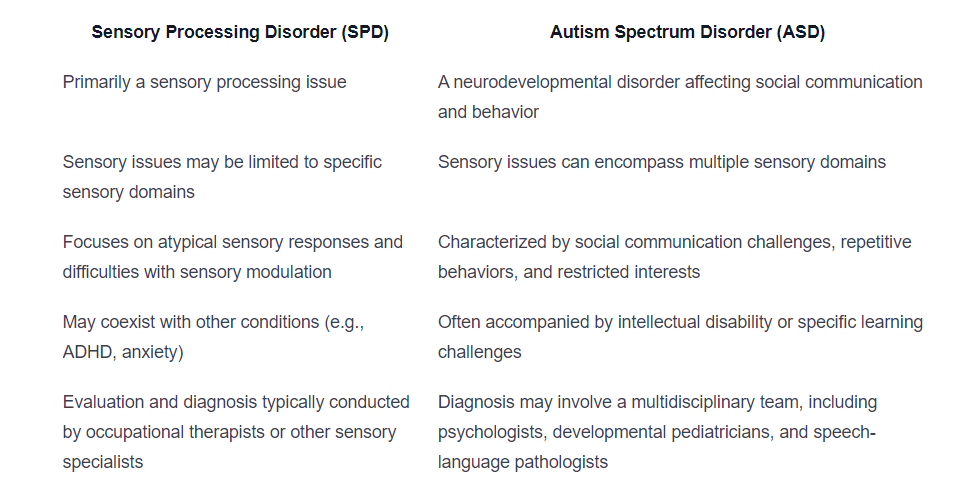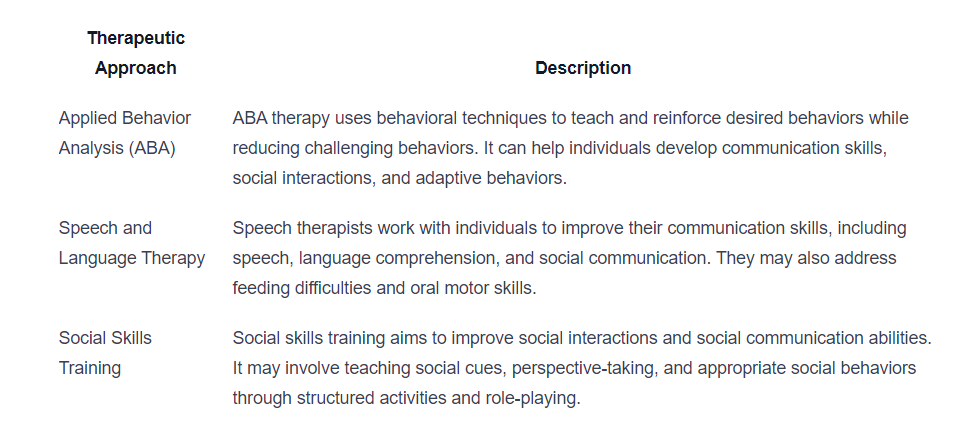Sensory Processing Disorder vs. Autism
Unveiling the distinctions: Sensory Processing Disorder vs. Autism. Understand the signs, diagnosis, and support for these conditions.

Understanding Sensory Processing Disorder (SPD)
Sensory Processing Disorder (SPD) is a condition that affects how the brain processes and responds to sensory information from the environment. Individuals with SPD may have difficulty regulating and interpreting sensory stimuli, leading to challenges in daily functioning. This section will provide an overview of SPD, including its definition, signs and symptoms, as well as its causes and risk factors.

What is Sensory Processing Disorder?
Sensory Processing Disorder, also known as Sensory Integration Dysfunction, is a neurological condition that affects the way an individual's brain processes sensory information. The sensory system includes the five main senses (sight, hearing, taste, smell, and touch), as well as other less recognized senses like proprioception (awareness of body position) and vestibular (balance and spatial orientation).
In individuals with SPD, the processing and integration of sensory information can be atypical. They may overreact or underreact to certain sensations, find it challenging to filter out irrelevant sensory input, or have difficulty organizing and responding to sensory stimuli in a coordinated manner. These difficulties can impact various aspects of their lives, including their behavior, emotions, attention, and motor skills.
Signs and Symptoms of SPD
The signs and symptoms of SPD can vary from person to person, as individuals may be affected differently by specific sensory stimuli. However, there are some common indicators that may suggest the presence of SPD. These can include:
- Hypersensitivity or overresponsiveness to sensory input, such as loud noises, bright lights, or certain textures.
- Hyposensitivity or underresponsiveness to sensory input, where individuals may seek out intense sensory experiences or have a high tolerance for pain.
- Difficulty with sensory discrimination, making it challenging to distinguish between similar sensations or identify the location of a touch.
- Poor sensory modulation, resulting in difficulties regulating emotional responses and behaviors in response to sensory input.
- Motor coordination challenges, such as difficulties with balance, posture, and fine or gross motor skills.
It's important to note that the signs and symptoms of SPD can overlap with those of other conditions, including Autism Spectrum Disorder (ASD). Therefore, a comprehensive evaluation by a healthcare professional is necessary for an accurate diagnosis.
Causes and Risk Factors of SPD
The exact causes of Sensory Processing Disorder are not yet fully understood. However, research suggests that a combination of genetic and environmental factors may contribute to its development. Some potential risk factors for SPD include:
- Genetic predisposition: There may be a genetic component that increases the likelihood of developing SPD.
- Premature birth or low birth weight: Individuals who were born prematurely or with a low birth weight may have a higher risk of experiencing sensory processing difficulties.
- Exposure to environmental toxins: Certain environmental factors, such as exposure to toxins during pregnancy or early childhood, may contribute to sensory processing challenges.
Further research is needed to fully understand the complex interplay of these factors in the development of SPD. By gaining a better understanding of the causes and risk factors, researchers and healthcare professionals can continue to advance their knowledge and provide effective interventions and support for individuals with SPD.
Understanding Autism Spectrum Disorder (ASD)
Autism Spectrum Disorder (ASD) is a neurodevelopmental disorder that affects individuals in various ways. It is characterized by difficulties in social interaction, communication challenges, and repetitive behaviors. Understanding the key aspects of ASD is essential in distinguishing it from Sensory Processing Disorder (SPD).
What is Autism Spectrum Disorder?
Autism Spectrum Disorder (ASD) is a complex developmental condition that typically appears during early childhood and lasts throughout a person's life. It affects individuals across a wide range of abilities and can present in different ways. ASD is characterized by challenges in social interaction and communication, as well as the presence of restricted and repetitive behaviors.
Signs and Symptoms of Autism
The signs and symptoms of Autism Spectrum Disorder can vary widely from person to person. However, some common characteristics include:
- Difficulty with social interactions: Individuals with ASD may struggle with understanding social cues, maintaining eye contact, and engaging in reciprocal conversations.
- Communication challenges: Some individuals with ASD may have delayed or impaired speech and language skills. Others may have difficulty understanding nonverbal communication, such as facial expressions and body language.
- Repetitive behaviors: People with ASD often engage in repetitive movements or behaviors, such as hand-flapping, rocking, or lining up objects in a specific order.
- Sensory sensitivities: Many individuals with ASD have heightened sensitivity to sensory stimuli, such as lights, sounds, textures, or smells. Conversely, some may seek out certain sensory experiences.
- Rigidity in routines: Individuals with ASD may prefer strict routines and have difficulty with changes in their environment or daily activities.
- Specialized interests: Some individuals with ASD develop intense interests in specific topics or activities, often focusing on very narrow areas.
Causes and Risk Factors of Autism
The exact causes of Autism Spectrum Disorder are still not fully understood. However, research suggests that a combination of genetic and environmental factors contribute to the development of ASD. Some potential risk factors include:
- Genetic factors: Certain genetic mutations, as well as a family history of ASD, may increase the risk of developing the disorder.
- Environmental factors: Prenatal exposure to certain medications, infections, or toxins during pregnancy may be associated with an increased risk of ASD.
- Brain development: Differences in brain structure and function have been observed in individuals with ASD, indicating that abnormalities in early brain development may play a role.
Understanding the characteristics and causes of Autism Spectrum Disorder is crucial in differentiating it from Sensory Processing Disorder (SPD). While there may be overlapping features between the two, recognizing the distinct aspects of each condition is essential for accurate diagnosis and appropriate intervention.
Recognizing the Differences
When it comes to sensory processing disorder (SPD) and autism spectrum disorder (ASD), there are both overlapping characteristics and key differences that distinguish these two conditions.
Overlapping Characteristics
SPD and ASD share some commonalities in terms of sensory issues and behaviors. Individuals with both conditions may experience difficulties with sensory processing, leading to challenges in responding to and interpreting sensory information from their environment. These shared characteristics can include:
- Hypersensitivity or hyposensitivity to sensory stimuli (e.g., sound, touch, taste, smell, visual input)
- Overwhelm or distress in response to sensory input
- Difficulty with transitions and changes in routine
- Social and communication difficulties
- Repetitive behaviors or restricted interests
It is important to note that while these characteristics may overlap, they are not exclusive to either SPD or ASD. A comprehensive evaluation by a qualified professional is necessary to determine the specific diagnosis.
Key Differences between SPD and Autism
Although SPD and ASD can exhibit similar characteristics, there are key differences that help distinguish between the two conditions. Understanding these differences can aid in accurate identification and appropriate support. Here are some important distinctions:

It is important to note that while SPD and autism have distinct features, they can coexist in some individuals. In such cases, a comprehensive evaluation is crucial to fully understand and address the individual's unique needs.
By recognizing the overlapping characteristics and key differences between SPD and autism, individuals, families, and professionals can better navigate the complexities of these conditions. Seeking professional evaluation and support is essential for accurate diagnosis and the development of appropriate interventions and strategies to promote optimal well-being and quality of life.
Diagnosis and Evaluation
When it comes to sensory processing disorder (SPD) and autism, obtaining a proper diagnosis is crucial in order to provide appropriate support and interventions. Seeking professional help is the first step towards understanding and addressing these conditions. Let's explore the diagnostic process for both SPD and autism.
Seeking Professional Help
If you suspect that you or a loved one may have sensory processing disorder or autism, it is important to consult with a healthcare professional who specializes in these areas. This could be a developmental pediatrician, child psychologist, occupational therapist, or other qualified healthcare provider. They will conduct a comprehensive evaluation to assess the individual's symptoms, behaviors, and developmental history.
During the evaluation, the healthcare professional will gather information from various sources, including interviews with the individual and their family members, observation of the individual's behavior, and standardized assessments. It is important to provide the professional with accurate and detailed information about the individual's experiences and challenges.
Diagnostic Process for SPD
Diagnosing sensory processing disorder involves a thorough evaluation of the individual's sensory responses and behaviors. The Diagnostic and Statistical Manual of Mental Disorders (DSM-5) does not currently include SPD as a standalone diagnosis, but it recognizes sensory issues as a part of other conditions such as autism or attention-deficit/hyperactivity disorder (ADHD).
The evaluation for SPD typically involves a combination of parent and teacher questionnaires, clinical observations, and assessments conducted by an occupational therapist. These assessments aim to evaluate the individual's responses to sensory stimuli, such as touch, sound, taste, and movement. The results help identify the presence and severity of sensory processing difficulties.
Diagnostic Process for Autism
Diagnosing autism spectrum disorder (ASD) involves a comprehensive evaluation that assesses the individual's social interactions, communication skills, and restricted and repetitive behaviors. The diagnostic criteria for autism are outlined in the DSM-5.
The evaluation process for autism typically includes interviews with the individual and their family members, developmental and medical history reviews, and direct observation of the individual's behavior. Standardized assessments, such as the Autism Diagnostic Observation Schedule (ADOS) and the Autism Diagnostic Interview-Revised (ADI-R), may also be used to gather additional information and aid in the diagnosis.
It is important to note that the diagnostic process for both SPD and autism may take time and involve multiple professionals. The expertise of healthcare providers specializing in these areas is essential in order to make an accurate diagnosis and develop an appropriate treatment and support plan.
By seeking professional help and undergoing a comprehensive evaluation, individuals with sensory processing disorder or autism can receive the necessary support and interventions to help them thrive and reach their full potential.
Treatment and Support
When it comes to supporting individuals with sensory processing disorder (SPD) and autism spectrum disorder (ASD), a comprehensive approach that addresses their unique needs is essential. Therapeutic interventions and supportive strategies play a crucial role in helping individuals navigate their sensory experiences and improve their overall quality of life.
Therapeutic Approaches for SPD
Therapeutic interventions for sensory processing disorder aim to help individuals develop effective coping mechanisms and regulate their sensory responses. These approaches focus on creating a sensory-friendly environment and providing targeted sensory integration therapy. Here are some common therapeutic approaches for SPD:

Therapeutic Approaches for Autism
For individuals with autism spectrum disorder, therapeutic interventions focus on addressing the core symptoms of autism, including sensory sensitivities and social communication challenges. Here are some common therapeutic approaches for autism:

Supportive Strategies for Individuals and Families
In addition to therapeutic interventions, supportive strategies can greatly enhance the well-being of individuals with SPD and autism, as well as their families. These strategies focus on creating a supportive and inclusive environment that promotes understanding and acceptance. Here are some supportive strategies for individuals and families:
- Education and Awareness: Educating oneself and others about SPD and autism can foster empathy, reduce stigma, and promote inclusion and acceptance in various settings.
- Sensory Diet: Developing a personalized sensory diet can help individuals with SPD manage their sensory needs throughout the day. This may involve incorporating sensory activities, breaks, and accommodations into daily routines.
- Individualized Education Plan (IEP): Collaborating with schools to create an IEP can ensure that individuals with SPD or autism receive appropriate accommodations and support to succeed academically and socially.
- Support Groups and Community Engagement: Connecting with support groups and engaging in community activities can provide individuals and families with a sense of belonging, support, and shared experiences.
By utilizing therapeutic approaches tailored to the specific needs of individuals with SPD and autism, along with implementing supportive strategies, we can empower them to thrive and reach their full potential. It's important to remember that each person is unique, and a multidimensional approach that considers their individual strengths and challenges is key to their overall well-being.
Sources
https://www.abtaba.com/blog/sensory-processing-disorder-vs-autism
https://www.medicalnewstoday.com/articles/sensory-processing-disorder-vs-autism
https://www.autismparentingmagazine.com/autism-sensory-processing-disorder/
Similar articles
We’re here to help you

Our team is here to assist you in this process. Contact us for any assistance.
it’s easy to apply
We Accept Most Insurances
Our in-network insurance partnerships make ABA therapy more accessible to families throughout our service areas.







Our Insurance Process
We'll request your insurance details to help us verify your plan's coverage for ABA therapy. Once we've received this information, we'll walk you through your benefits, including copayments, deductibles and out-of-pocket maximums, so you know what to expect in advance.
Our team will then handle the preauthorization and all the necessary paperwork.
.svg)





















.jpeg)


































.jpeg)




.jpeg)







.jpeg)











.jpeg)
















